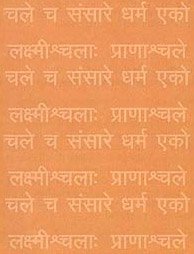Yadartha, Yadārtha: 7 definitions
Introduction:
Yadartha means something in Hinduism, Sanskrit, Marathi. If you want to know the exact meaning, history, etymology or English translation of this term then check out the descriptions on this page. Add your comment or reference to a book if you want to contribute to this summary article.
In Hinduism
Vedanta (school of philosophy)
Source: Shodhganga: Siva Gita A Critical StudyYadārtha (यदार्थ) or Yadārthagītā refers to one of the sixty-four Gītās commonly referred to in Hindu scriptures.—Gītā is the name given to certain sacred writings in verse (often in the form of a dialogue) which are devoted to the exposition of particular religious and theosophical doctrines. Most of these Gītās [i.e., Yadārtha-gītā] originate from the Mahābhārata or the various Purāṇas.

Vedanta (वेदान्त, vedānta) refers to a school of orthodox Hindu philosophy (astika), drawing its subject-matter from the Upanishads. There are a number of sub-schools of Vedanta, however all of them expound on the basic teaching of the ultimate reality (brahman) and liberation (moksha) of the individual soul (atman).
Languages of India and abroad
Marathi-English dictionary
Source: DDSA: The Molesworth Marathi and English Dictionaryyadartha (यदर्थ).—ad (S) For the reason or business which; on the account or ground which.
Source: DDSA: The Aryabhusan school dictionary, Marathi-Englishyadartha (यदर्थ).—ad For the reason or business which.
Marathi is an Indo-European language having over 70 million native speakers people in (predominantly) Maharashtra India. Marathi, like many other Indo-Aryan languages, evolved from early forms of Prakrit, which itself is a subset of Sanskrit, one of the most ancient languages of the world.
Sanskrit dictionary
Source: Cologne Digital Sanskrit Dictionaries: Cappeller Sanskrit-English DictionaryYadartha (यदर्थ).—[adjective] having which object or intention.
Source: Cologne Digital Sanskrit Dictionaries: Monier-Williams Sanskrit-English DictionaryYadartha (यदर्थ):—[=yad-artha] [from yad] mfn. having which object or intention, [Bhāgavata-purāṇa]
[Sanskrit to German]
Sanskrit, also spelled संस्कृतम् (saṃskṛtam), is an ancient language of India commonly seen as the grandmother of the Indo-European language family (even English!). Closely allied with Prakrit and Pali, Sanskrit is more exhaustive in both grammar and terms and has the most extensive collection of literature in the world, greatly surpassing its sister-languages Greek and Latin.
See also (Relevant definitions)
Starts with: Yadarthagita, Yadartham, Yatarttam, Yatarttavati.
Ends with: Anyadartha.
Full-text: Yadartham, Yadarthe, Yadarthim, Ayathartha, Abhisambhavayati, Yadarthagita, Darshita, Cud, Kritavat, Arambha, Artha.
Relevant text
Search found 6 books and stories containing Yadartha, Yad-artha, Yadārtha; (plurals include: Yadarthas, arthas, Yadārthas). You can also click to the full overview containing English textual excerpts. Below are direct links for the most relevant articles:
Hanuman Nataka (critical study) (by Nurima Yeasmin)
Dvisahasri of Tembesvami (Summary and Study) (by Upadhyay Mihirkumar Sudhirbhai)
Chaitanya Bhagavata (by Bhumipati Dāsa)
Verse 3.10.177 < [Chapter 10 - The Glories of Śrī Puṇḍarīka Vidyānidhi]
A History of Indian Philosophy Volume 3 (by Surendranath Dasgupta)
Part 12 - Epistemology of the Rāmānuja School according to Meghanādāri and others < [Chapter XX - Philosophy of the Rāmānuja School of Thought]
A History of Indian Philosophy Volume 5 (by Surendranath Dasgupta)
Part 2 - Śaiva Philosophy in the Vāyavīya-saṃhitā of the Śiva-mahāpurāṇa < [Chapter XXXVII - The Śaiva Philosophy in the Purāṇas]